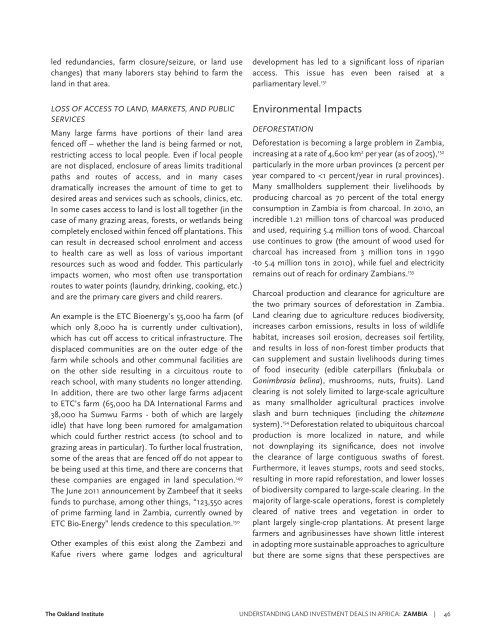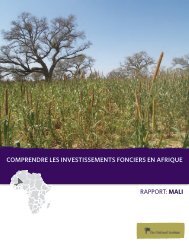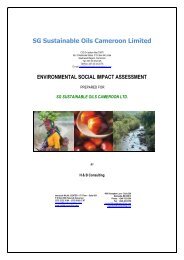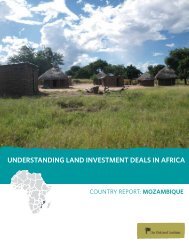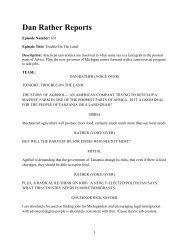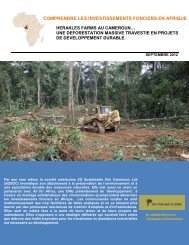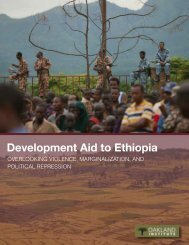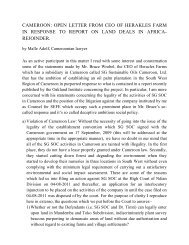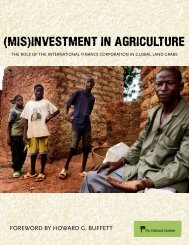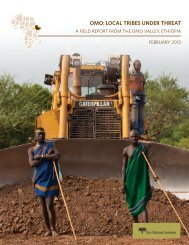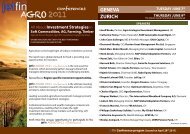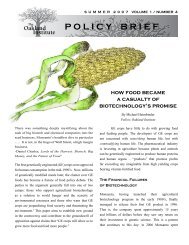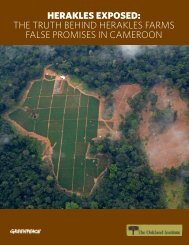Zambia - Oakland Institute
Zambia - Oakland Institute
Zambia - Oakland Institute
You also want an ePaper? Increase the reach of your titles
YUMPU automatically turns print PDFs into web optimized ePapers that Google loves.
led redundancies, farm closure/seizure, or land use<br />
changes) that many laborers stay behind to farm the<br />
land in that area.<br />
LOSS OF ACCESS TO LAND, MARKETS, AND PUBLIC<br />
SERVICES<br />
Many large farms have portions of their land area<br />
fenced off – whether the land is being farmed or not,<br />
restricting access to local people. Even if local people<br />
are not displaced, enclosure of areas limits traditional<br />
paths and routes of access, and in many cases<br />
dramatically increases the amount of time to get to<br />
desired areas and services such as schools, clinics, etc.<br />
In some cases access to land is lost all together (in the<br />
case of many grazing areas, forests, or wetlands being<br />
completely enclosed within fenced off plantations. This<br />
can result in decreased school enrolment and access<br />
to health care as well as loss of various important<br />
resources such as wood and fodder. This particularly<br />
impacts women, who most often use transportation<br />
routes to water points (laundry, drinking, cooking, etc.)<br />
and are the primary care givers and child rearers.<br />
An example is the ETC Bioenergy’s 55,000 ha farm (of<br />
which only 8,000 ha is currently under cultivation),<br />
which has cut off access to critical infrastructure. The<br />
displaced communities are on the outer edge of the<br />
farm while schools and other communal facilities are<br />
on the other side resulting in a circuitous route to<br />
reach school, with many students no longer attending.<br />
In addition, there are two other large farms adjacent<br />
to ETC’s farm (65,000 ha DA International Farms and<br />
38,000 ha Sumwu Farms - both of which are largely<br />
idle) that have long been rumored for amalgamation<br />
which could further restrict access (to school and to<br />
grazing areas in particular). To further local frustration,<br />
some of the areas that are fenced off do not appear to<br />
be being used at this time, and there are concerns that<br />
these companies are engaged in land speculation. 149<br />
The June 2011 announcement by Zambeef that it seeks<br />
funds to purchase, among other things, “123,550 acres<br />
of prime farming land in <strong>Zambia</strong>, currently owned by<br />
ETC Bio-Energy” lends credence to this speculation. 150<br />
Other examples of this exist along the Zambezi and<br />
Kafue rivers where game lodges and agricultural<br />
development has led to a significant loss of riparian<br />
access. This issue has even been raised at a<br />
parliamentary level. 151<br />
Environmental Impacts<br />
DEFORESTATION<br />
Deforestation is becoming a large problem in <strong>Zambia</strong>,<br />
increasing at a rate of 4,600 km 2 per year (as of 2005), 152<br />
particularly in the more urban provinces (2 percent per<br />
year compared to


